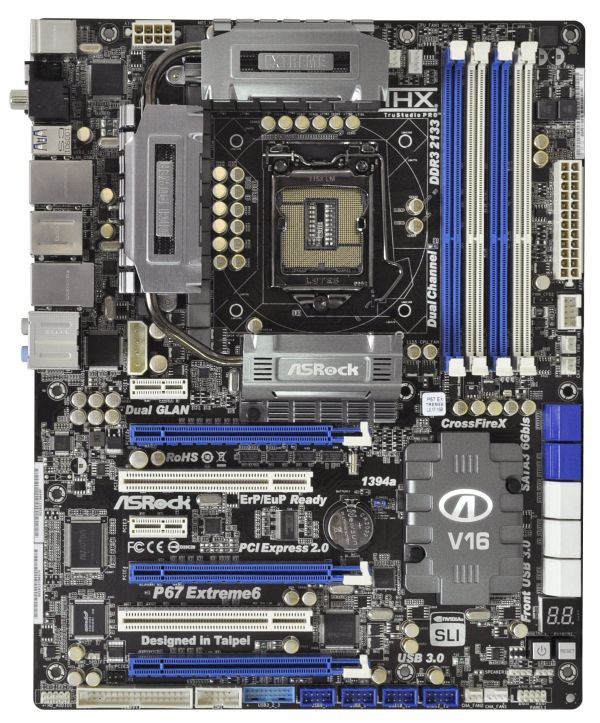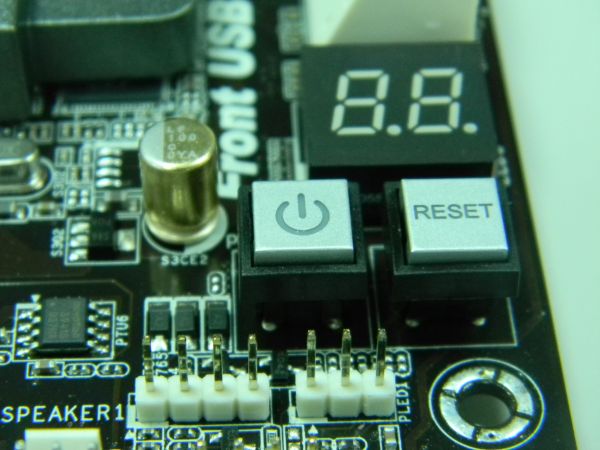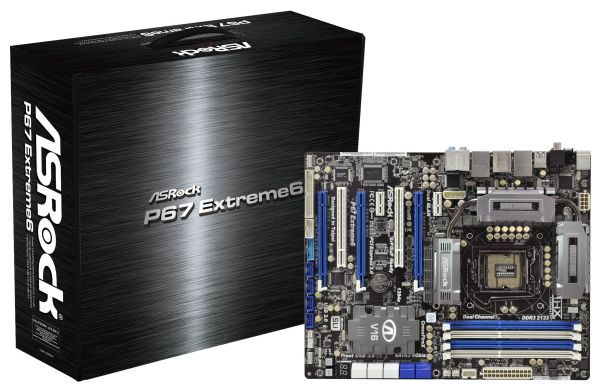P67 $190 Part 2: MSI P67A-GD65, ASRock P67 Extreme6 and ECS P67H2-A2
by Ian Cutress on May 10, 2011 1:36 AM EST- Posted in
- Motherboards
- MSI
- ASRock
- P67
- ECS
- Cougar Point
ASRock P67 Extreme6: Overview
I’m writing this after I’ve tested this board, and my overall impression is that ASRock are hitting the nail on the head with regards to ease of use and options on their products. ASUS are ASRock’s parent company, and we can definitely see the essence of one transferring into the other—a stark change from ASRock’s initial prerogative as a contender in the commodity OEM market. The P67 Extreme6, which is currently retailing at $210 (above the original $190 RRP) offered a great overclock as well as the ASRock plethora of extras that come with the board, including that USB 3.0 bracket which doubles as an SSD holder. The main criticism with ASRock boards, as it always usually is, comes with the one year warranty, and also whether this board is worth the $50 more than the P67 Extreme4, which we reviewed in our first look at P67.
ASRock P67 Extreme6: Visual Inspection
A few things glare out the minute you look at the board and the CPU socket area—to start, we have a large combined heatsink setup, designed to conduct heat around the 16+2 phase VRM power solution as well as the PCH contained underneath the bottom heatsink. In the CPU socket, we find ASRock’s Combo Cooler Option, allowing users to utilize their old socket 775 cooling, as well as a series of gold based capacitors. Previous ASRock chipset boards (think the X58 Extreme3) required fan support on the VRM heatsink, but this one does its job without one.
There is an abundance of fan headers on this motherboard—above the CPU socket there are two CPU fan headers, one 4-pin and one 3-pin; below the 24-pin ATX power connector there is another couple labeled CHA and PWR, and finally another two are found at the bottom right, both chassis fans. In the BIOS there are fan controls for all of these except the PWR header.
Continuing down the right hand side of the board is a FireWire connector for a front panel Firewire connector, and 10(!) SATA ports. The four blue are SATA 3 Gbps ports from the PCH, and six white SATA 6 Gbps ports—two from the PCH, and two sets of two powered by Marvell SE9120 controllers. One of these Marvell controllers also controls the eSATA 6 Gbps port, so both cannot be used at the same time. Unfortunately, only the SATA 3 Gbps support RAID.
Thankfully we see the power/reset/debug LED we’d expect with a board at this price, and above this is a heatsink labeled ‘V16’ housing a PLX PEX8608 chip to supply extra PCI-E lanes for 3+ GPU setups at the expense of board power consumption. The PCIe layout gives a PCIe 1x limited in width by the PCH heatsink, and the standard array of PCIe x16, PCIe x1 and PCI slots. By giving enough space for a triple slot cooler to the first PCIe x16, this offers space between a dual two-slot cooler PCIe setup, but in here is also a PCIe x1 without width restrictions. If all PCIe slots are populated with dual slot GPUs, apart from running at x8/x8/x4, a lot of the connectors at the bottom of the board are compromised, such as the legacy floppy port. More importantly though, the Front Panel connector would easily be obscured by anything bigger than a 4850, thus limiting tri-GPU setups to single slot cards or people using this board for overclocking on an open test bed.
The I/O panel offer dual PS/2 connectors, the ubiquitous clear CMOS button we like to see, optical and coaxial S/PDIF outputs, dual gigabit Ethernet ports powered by Realtek NICs, a Firewire port, that eSATA 6 Gbps port, four USB 2.0 ports, four USB 3.0 ports powered by an Etron controllers, and the standard Realtek audio setup supporting THX TruStudio Pro.















27 Comments
View All Comments
Etern205 - Tuesday, May 10, 2011 - link
Didn't read the article yet, but IMO most P67 based boards within the same price range are similar to one another and in the past if I was looking for a board, I'll read every damn review on the product I want. Now, it's just pick a damn board with the features you like to have and be happy with it.fic2 - Tuesday, May 10, 2011 - link
Still can't get rid of the legacy PS/2 port.... Just makes me laugh.Etern205 - Tuesday, May 10, 2011 - link
What is there to laugh about?Some still have a good PS/2 devices which is a waste just to junk it out and PS/2 has a faster detection over USB. This benefits users who wants to access the bios where USB keyboards sometimes fails miserably.
The most expensive SNB board from Asus still has a PS/2 port (combo PS/2).
http://www.newegg.com/Product/Product.aspx?Item=N8...
Hrel - Tuesday, May 10, 2011 - link
Can someone please explain to me why despite the fact that more and more chips are moving off the motherboard and onto the CPU motherboards seem to keep getting more and more expensive. Ok, increased power delivery testing; I get that. But the motherboard manufacturers are literally buying fewer chips to make their board. These things should be getting cheaper!The northbridge is on the CPU, the iGPU is on the CPU and that right there is the majority of the cost of a motherboard. Seriously, WTF! $190 is the sweetspot? WTF! $130 bought a hell of a board 3-5 years ago. Now they're cheaper to make but cost more? WTF! I shouldn't be spending anymore than 100 bucks on a brand new Asus P5NE-SLI class motherboard. I'm an enthusiast, we should be seeing tons of these things for 50 bucks. WTFFFFFFFFFFF!
ggathagan - Tuesday, May 10, 2011 - link
You're paying $100 for a brand new P5NE-SLI because it's obsolete technology which translates into higher support costs for the manufacturer.The same can be said for SDRAM, the original DDR RAM and Socket 478 CPU's.
As to why a *modern* motherboard costs so much with more of the chipset being integrated into the CPU: They don't.
You can get a LGA1155 motherboard for under $50 and $130 still gets you "a hell of a board ".
P67-based motherboards are not at the low end of the market, so any decently featured mid-tier motherboard remains in the $150-$200 range.
Regardless of what Intel or AMD incorporate into the CPU, the support chipsets *still* need to be purchased.
AMD and Intel set the price for that, not Asus, MSI, Gigabyte, etc...
Sound and LAN support remain seperate from the core chipset.
Lastly, in the case of Intel systems, there is the desire for USB 3.0 support that has to be added via additonal chips.
Upper tier boards have never been about the chipset/CPU; they've always been about the "bells & whistles" factor.
As such, the buyer's perception of what is valuable is more of a factor than logic centering around what a specific chipset or CPU brings to the table.
TheJian - Wednesday, May 11, 2011 - link
I don't think a decently featured board costs $150-200. My current GByte board had all the bells and whistles for $129. The only thing missing from the top boards was more vid slots, and a few more Sata's (mine has 8 so plenty for me).http://www.newegg.com/Product/Product.aspx?Item=N8...
$70, has everything but Btooth/Firewire (who cares)/SLI (who cares). Includes both USB3 and 2 SATA 6 ports.
What features are there that cost another $130? I get that P67 adds another $30 (which is where P67 boards start on newegg), and we get overclocking for that (but we got screwed out of a vid card on that deal so hmmm).
http://www.newegg.com/Product/Product.aspx?Item=N8...
$110 for P67 Gigabyte D3 B3, USB3, Sata6. Missing Btooth/1394/SLI(xfire-either). We now know you can put USB3 on a $70 board (jetway has a $70 USB3 board too). They have an ECS for $100, and it has USB3 and even 2 vids.
So are these worth $100? A few more USB's and Btooth is all I'd ask for (and there's already plenty of USB). USB3 chip probably costs a few bucks at best (likely $1). They throw on audio for $1. I don't call the boards in this review mid tier. I'd say more like upper class. SLI/Xfire used to be all that was needed to put your board into upper class. It should still be that way. Unless it's a server board, anything over $200 is probably just a pretty box. Maybe someone else can point to a reason why prices shot up on the top end and the mid is considered by some as $150-200 (I thought it was $100-150, with the low being $60-100, but that's just me).
You can't say the dollar is dropping or bring up gold - I shouldn't be able to post a $70 full featured H67 or $100 full featured P67. The guy on the $100/P67 is overclocked at 4.8ghz (i7-2600K) and folding 24x7...ROFL. I think this board's a winner. Probably should be in your next review :) Might be a little low, but you get the point. Then again, this is probably what most will buy (or lower in the H67 range most likely).
Rookie Monster - Tuesday, May 10, 2011 - link
Two reasons come to mind.1. Gold is $1500oz
2. U.S. dollar is falling like a rock.
knedle - Tuesday, May 10, 2011 - link
I even found a movie on youtube showing MSI Games:http://www.youtube.com/watch?v=dmdoRfgNkCg
I think it may be usefull if your HDD with important data just died and you want to commit suicide. ;)
wifiwolf - Tuesday, May 10, 2011 - link
I'm with Hrel on this. It's just ridiculous that we're buying boards with less parts needed even more expensive then they were before moving northbridge and int-graphics.PS: Unfinished chipsets should be for beta testing and not for sale.
Patrick Wolf - Tuesday, May 10, 2011 - link
I agree, these boards should be cheaper (which could be said for most components really), but to be fair these aren't all $190 boards, they were at 1st but new tech is always more. Lowest current price I could find for each board is as follows:P67A-GD65 - $170 (newegg, could be even cheaper at superbiiz depending on promo)
P67 Extreme6 - $200 (superbiiz, again promo)
P67H2-A2 - $173 after MIR (newegg)
GA-P67A-UD4 - $175 after MIR (superbiiz, again promo)
P8P67 PRO - $180 (newegg/superbiiz, again promo)
Compare that to 775. The ever popular GA-EP45-UD3P was about $130 and now the GA-P67A-UD3 which has similar features is $125. Or better yet the MSI P67A-G43 for $125.